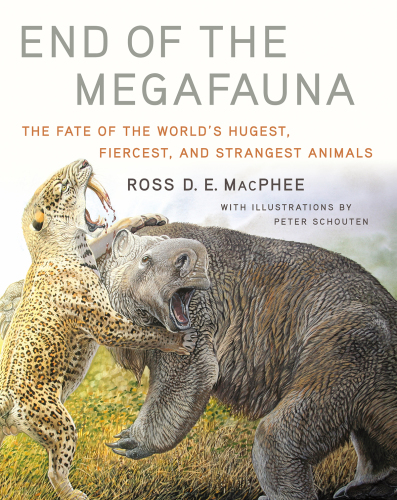
End of the Megafauna
The Fate of the World's Hugest, Fiercest, and Strangest Animals
کتاب های مرتبط
- اطلاعات
- نقد و بررسی
- دیدگاه کاربران
نقد و بررسی

September 1, 2018
Working the "borderland between archeology and paleontology," a paleomammalogist examines a suite of causes for the extinction of large animals during the late Pleistocene.In 1814, when John James Audubon observed a flock of passenger pigeons over the Ohio River, the population numbered in the untold billions. A century later, the last passenger pigeon died in a zoo. That, notes MacPhee (Race to the End: Amundsen, Scott, and the Attainment of the South Pole, 2010, etc.), who has worked at the American Museum of Natural History for three decades, is the "fastest decline on record for a vertebrate with an initially large population size"--and, he adds cautiously, the "most supported" cause is overhunting. Why the caution, when the historical record is full of accounts of passenger pigeons being blasted out of the sky? Because the author is wrestling with the thorny question of what brought on the deaths of so many large animals, including mastodons, marsupial lions, dodos, and baboon lemurs. In a noir film, the smoking gun would be in the hands of the humans who just happened to show around the time of extinction. In science, greater care must be taken in establishing causality, and even if MacPhee bridles at the line of argument established by Paul Martin and his followers blaming the megafaunal extinction on the human "blitzkrieg," he at least includes human killing among the causes. Others factors include climate change, the collapse of food webs, and the introduction of invasive species. Concluding that there is no compelling common cause in the extinctions, MacPhee closes by considering the possibilities of genetically reviving lost species, or "de-extinction," noting, finally, "it is to be hoped that any brave new creations can be integrated into existing ecosystems without destroying them--something we have been unable to do with ourselves, for at least the last 50,000 years."So why did all those critters go extinct? MacPhee suggests rather than asserts, but his book, featuring beautiful illustrations from Schouten, adds thoughtful fuel to a scholarly debate that shows no signs of ending.
COPYRIGHT(2018) Kirkus Reviews, ALL RIGHTS RESERVED.

September 17, 2018
MacPhee (Race to the End), a paleomammalogist with the American Museum of Natural History, critically examines theories on the extinction of many huge vertebrate species over the past 50,000 years in this lavishly illustrated volume. These “near time extinctions,” as MacPhee terms them, wiped out sabertooth cats, gorilla-sized lemurs, half-ton lizards, and other oversized species. At the outset, MacPhee declares, “all serious positions... deserve a hearing,” and he proceeds to demonstrate this point. Rigorously examining the evidence for and against various hypotheses, he shows that the two major contenders point to either “overkill”—excessive hunting by early humans—or climate change as the causes. MacPhee lays the groundwork for his discussion with chapters on the state of the world during this period, the spread of humans and their precursors, and earlier theories regarding “near time” extinctions. To enliven the text, the book includes cartoons, maps, graphs, sidebars on such topics as “Mammoth on the Menu,” and most importantly, Peter Schouten’s marvelous color illustrations of gomphotheres, diprotodonts, mammoths, and the rest. This is a must-read for anyone interested in the subject of animal extinctions, in the present or the past.

November 1, 2018
Over the past 50,000 years, enormous terrestrial animals have disappeared from every continent. Only rhinoceroses and elephants survive. No evidence points to a lone catastrophic event causing this extinction. With flashes of dry humor, paleomammalogist MacPhee (American Museum of Natural History;{amp}nbsp;Race to the End) critiques competing theories invoking climate change or human overkill. Neither explanation is completely supported by scientific understanding of known geologic, archeological, and fossil evidence. The question of whether the die-off was the result of yet another single process, or of an unfortunate coincidence of multiple stressors, is currently unresolved. The author's tone and style is most appropriate for readers who already possess a broad general knowledge of natural history and the scientific process. A brief glossary helps with occasionally unavoidable technical terminology. VERDICT Though the narrative can be somewhat repetitive, it still offers an accessible overview of evidence supporting and contradicting popular scientific theories, and Schouten's (A Gap in Nature) detailed color illustrations of an earlier world will captivate readers.{amp}mdash;Nancy R. Curtis, Univ. of Maine Lib., Orono
Copyright 2018 Library Journal, LLC Used with permission.

December 1, 2018
Humans are fascinated by big things, especially big animals. Except for elephants and rhinos, all of the largest land animals are now extinct. End of the Megafauna looks at near-time extinctions, which are those that occurred within the last 50,000 years or so. This excludes the dinosaurs but does include mammoths, saber-tooth tigers, ground sloths, giant crocodiles, and moa birds. Paleomammologist MacPhee (American Museum of Natural History in New York) discusses the disappearance of these giant animals and speculates on the reasons that they are no longer with us. Causes for extinction include climate variations, environmental disasters, and overhunting by early humans. In addition to the text, the illustrated book contains appendixes presenting techniques for dating fossils, a glossary of terms, and an extensive bibliography. MacPhee's research, combined with award-winning artist Schouten's illustrations, makes for a book that will fascinate and draw attention to the loss of these interesting and unusual species.(Reprinted with permission of Booklist, copyright 2018, American Library Association.)

























دیدگاه کاربران